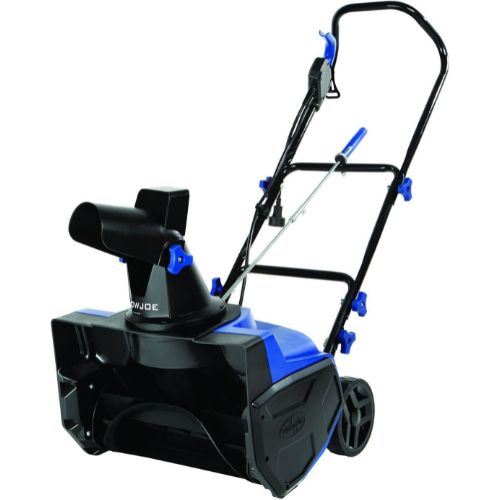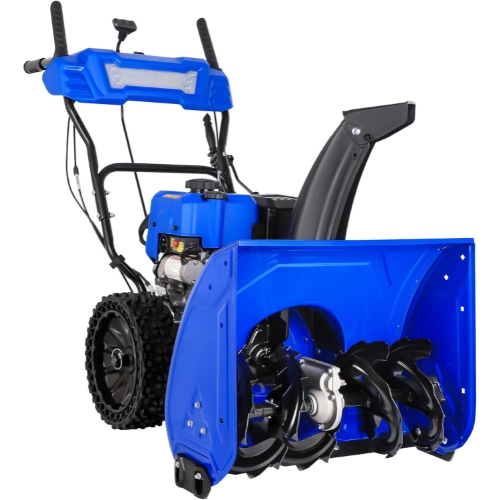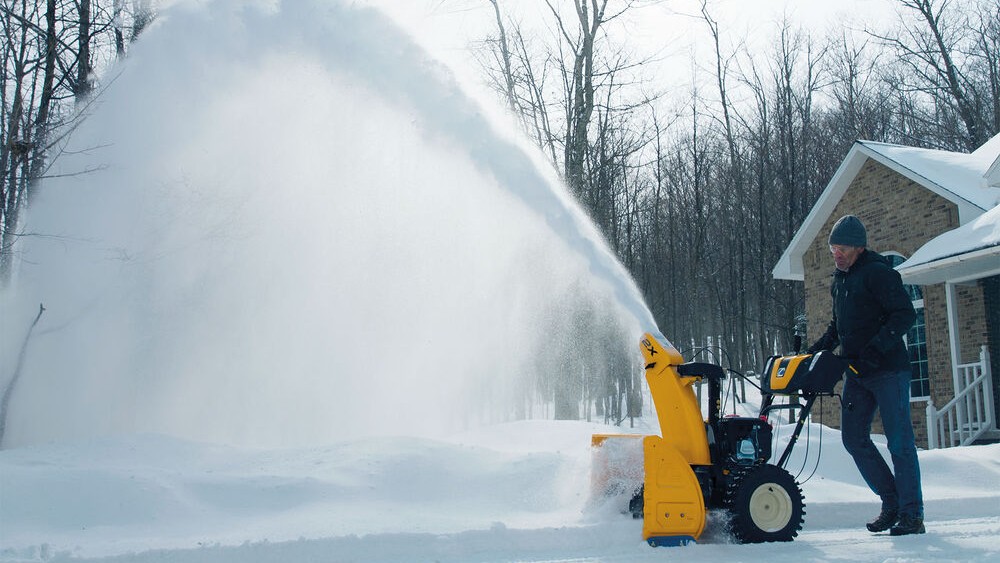
The lightweight, easy-to-handle Snow Joe SJ618E is the ideal snow thrower for quick snow removal on small to medium-sized areas, including porches, walkways, and single-car driveways. The 13-amp motor moves up to 550 pounds of snow per minute. Featuring a smaller 18-inch mouth, it can maneuver small areas like a deck with ease. With fewer components and no gas, there’s little maintenance involved, eliminating the need for gas and oil tune-ups.
For
- Maintenance free
- Ideal for quick removal
Against
- Limited features

The heavy-duty Hykolity 24-inch Two-State Snow Blower is a great choice choice when handling those dreaded winter storms. Featuring a dual start-up option, this snow blower is reliable and quick to start. With a powerful seven-horsepower, four-cycle engine, you can expect to finish the daunting chore of snow removal in a fraction of the time with way less physical strain. That’s partially due to a self-propelling six-speed forward drive motor with two reverse speeds. Those sloped driveways are no match for the Hykolity.
For
- Larger mouth for wider passes
- Effortless starting
Against
- Heavy
Picture this – it’s 6 am on a cold December morning, and as you’re pouring your initial cup of joe to start the day, you look outside to see a fresh foot of snow covering your walkways. Shoveling before or even after that cup of coffee sounds pretty daunting, but it doesn’t have to be. Snow removal machines, like snow blowers and snow throwers, make clearing a sidewalk or a two-car driveway a quick job without back-breaking effort. You may notice the terms “snow thrower” and “snow blower” are used interchangeably, but they are different in terms of functionality, power, and price.
The term blower vs thrower depends on how many stages are involved in removing snow, which is explained in more detail in the design section of this article. But the TL;DR version – two-stage snow blowers remove more snow and throw it further than a single-stage snow thrower. Some of the best snow blowers are capable of clearing over a two-foot path in a single pass and can throw the snow up to 40 feet away. In areas with long winters with heavy snow, these two-stage blowers can significantly reduce time spent on winter chores. However, that extra power will cost you running anywhere between $500 and $2500.
Now, let’s say you live in a condo or you only have a few sidewalks to clear; a snow thrower is best suited for smaller jobs and light snow accumulations of no more than nine inches. They are also significantly more budget-friendly, coming in anywhere between $100 to $300. With an 18-inch clearing width and a 20-foot throwing range, you can see why a snow thrower, like the Snow Joe SJ618E, is a solid choice for smaller jobs.
Both snow blowers and snow throwers are offered with different power sources. While most blowers are gas-powered, there are electric and even battery-powered options available. Hykolity’s two-stage snow blower has taken powering the engine up another level by offering both an electric and gas starting option within the same machine.
When deciding whether it’s worth buying a snow blower or snow thrower, it is important to consider the average winter conditions in your area and how large of an area you need to keep clear. If you are like me, being hammered with snow a few times a week, shoveling is simply back-breaking work, and a snow blower is a must.
Snow Blower vs Snow Thrower: Design
Snow throwers are straightforward, easy to use, and typically require less upkeep. The easiest way to differentiate between a thrower and a blower is in the way they tackle the snow. In a single-stage thrower, the auger breaks up the snow and throws it through the chute in one swift motion. In a two-stage blower, the auger first shreds the snow and ice and then uses the second-stage impeller (which is essentially a powerful fan) to propel it through the chute, hurling the snow a much further distance.
The Snow Joe SJ618E Single-Stage Thrower has an electric-powered 40-volt engine. It’s designed with a two-blade plastic auger with the ability to clear a path up to 18 inches wide and eight inches deep. Designed with a 13-amp motor, you can move up to 55 pounds of snow per minute. With a 180-degree adjustable directional chute, you can expect to “throw” snow up to 20 feet in any direction, preferably not in your neighbor's driveway.
Unlike snow throwers, snow blowers are larger and often made with heavy-duty steel augers to break up wet and heavy snow with ease. Each design feature has been crafted to tackle large winter jobs, including commercial spaces.
The Hykolity 24 24-inch two-stage gas-powered blower is easy to start and designed with both a 120-volt electric start and a pull-to-start backup option. Featuring a 209cc four-cycle engine, it can blow snow up to 3,000 lbs per minute, a significant increase from the Snow Joe. The Hykolity is designed with a large 24-inch mouth, making it easier to clear snow from wider areas, such as a multi-car driveway or wider sidewalks, with fewer passes. Equipped with 13-inch flat-free tires, this blower was made to handle icy conditions with solid traction.
Verdict: The snow thrower is electric and smaller than the snow blower, but don't be fooled; it can still shift up to 55 pounds of snow. It would be better suited to clearing less dense snow or where there hasn't been a tonne of snow that has dropped. The snow blower is gas-powered and looks a lot more serious - its chunky wheels will perform much better in icy conditions, too.

Snow Blower vs Snow Thrower: Features
While both options will most certainly move snow faster and with more precision than a stiff back and shovel any day, let’s discuss the must-have features for each.
Hykolity’s two-stage blower packs in a lot of must-have features. This includes effortless starting options, both a 120-volt electric option and a pull-start backup. Featuring a powerful seven-horsepower four-cycle engine, this machine can cut through heavy and wet snow up to 3,000 pounds per minute. Unlike the Snow Joe snow thrower, which utilizes a plastic auger blade, the two-stage snow blower includes a 10-inch heavy-duty steel auger that can break up snow and ice.
This blower also features a self-propelling design with six drive speeds forward as well as two reverse speeds, providing you with multiple options depending on the thickness of the snow. This is also a great added benefit when dealing with sloped driveways and pathways, giving you more control while letting the self-propel feature do the work.
And with the sun setting earlier in the day, we find ourselves more often working in dimly lit conditions. The handy LED headlight on the Hykolity makes it easier for early morning and late night snow removal.
Don’t let the smaller frame fool you, the Snow Joe snow thrower has quite a few perks too. While this machine is designed for smaller jobs, it still features a decently powered 13-amp motor with the ability to move up to 550 pounds per minute. The Snow Joe is also lightweight and easy to handle. And thank goodness for the lightweight build. Like most snow throwers, the Snow Joe SJ618E is not self-propelled which can make it difficult to operate in thicker snow conditions. With a corded power source, you don’t have to worry about the cost of gas. With such a simple design, this snow thrower, and throwers in general, are simpler to maintain.
Verdict: if you're looking for easy use and maintenance, then a smaller, more nibble snow thrower wins hands down for a quick snow clear. The snow blower we're comparing here, however, features a 10-inch heavy-duty steel auger that can break up snow and ice, so it will essentially break through anything.
Snow Blower vs Snow Thrower: Performance
When it comes to power, there is a clear difference between the Snow Joe SJ618E and the Hykolity 24-inch Two-Stage Snow Blower. The Snow Joe is powered by a 13-amp motor, while the Hykolity utilizes a seven horsepower engine. Not to get too crazy down the math rabbit hole, but to simplify the difference, seven horsepower is approximately over 22 amps, allowing the Hykolity to draw more power and perform tougher tasks.
Depending on the area you live in, having extra power may be critical. For climates that get a lot of snow or heavy, wet snow, you can wait till the storm has passed, then go outside and clear all of the snow with a snow blower in a single job. With a snow thrower in the same climate, you may have to repeatedly go outside and clear snow as it comes so it doesn’t become too heavy for the auger to propel.
Another factor we consider for performance is how much snow we can clear in the least amount of time. Due to the wider mouth and throwing capacity of the Hykolity, you can expect to finish the job in a shorter amount of time compared to using a snow thrower. It’s fairly simple – a wider mouth equals fewer passes. This may not seem like a big deal initially, but over the course of a big clearing job, it could reduce your time outside in the cold by a lot.
Verdict: if you want to clear snow quickly and/or have a lot of snow to shift, then the snow blower is the best tool for the job. It has more power and a heavier build quality than the snow thrower, making it suitable for icy conditions. A snow thrower, on the other hand, may mean that you repeatedly have to go outside to finish the job in between snow dumps.

Snow Blower vs Snow Thrower: care & maintenance
Both single-stage snow throwers and two-stage snow blowers require maintenance. That being said, the Snow Joe snow thrower requires significantly less care due to its power source being electrical. This means no oil changes, gas flushes, or engine tune-ups. This doesn’t mean zero maintenance, though. The auger blades, belts, and chutes still need to be checked regularly and occasionally replaced.
Two-stage snow blowers do require more care especially when storing the blower during the off-season. One advantage to the Hykolity’s two-stage blower is the use of heavy-duty steel auger blades. These rarely need replacement, but they do still need to be maintained and cleaned.
With a gas-powered machine, there are some winterization tasks that need to be performed to keep it running season after season. This includes emptying fuel lines, unclogging any lines, and lubricating the blower components (per the manufacturer’s instructions).
Verdict: While both machines require some level of maintenance, the snow thrower demands significantly less care simply because it is electric and doesn't come with any associated ongoing costs like the gas-powered snow blower will.
Snow Blower vs Snow Thrower: Price & availability
The simplicity the Snow Joe snow thrower offers makes it significantly more affordable than the Hykolity’s two-stage blower. When considering the price point of each of these machines, it is crucial to consider performance needs; do you have a sloped driveway? Are you on a corner lot with endless sidewalks (like my house)? Do you anticipate removing snow several days a week?
There are a few things that influence the price point, such as features, clearing width, and the power source. While we primarily focused on electrical throwers vs gas-powered blowers, another option is battery-powered blowers such as the EGO POWER+ (but you can still expect to pay over $600).
The Snow Joe Electric Single-Stage Snow Thrower comes in at $169.99. They are available at Snow Joe’s website, Home Depot, and even Amazon.
The Hykolity’s Gas Two-Stage Snow Blower comes in at $649.99 and is available on Amazon.
Verdict: To put it simply, a two-stage snow blower will cover just about all of your snow removal needs, but you can expect to spend more for that capability. To compare the two, a single-stage snow thrower can cost as low as $82, while a two-stage will easily set you back $500.
Snow Blower vs Snow Thrower: Our verdict
While both the Snow Joe Single-Stage Snow Thrower and Hykolity Two-Stage Snow Blower are great choices, we imagine one suits your needs more than the other. It comes down to the size of the job, how often you will need it, and the budget.
If you have a smaller area to clean, in a location with mild winters, the Snow Joe should be enough. You do sacrifice added power and features, but it’ll work for those on a budget.
Unless you are a true snow dweller, you might not get the full value of a two-stage snow blower like the Hykolity. Living on a corner lot in high elevation, my neighborhood experiences some of the worst snow storms. For my situation, the two-stage is the only choice.
Snow Blower vs Snow Thrower: FAQs
Is a snow blower better than shoveling?
Shoveling can be a quick, hassle-free way to remove small amounts of snow from a porch or a deck. It isn’t the most realistic choice when tackling larger driveways and sidewalks. Shoveling can be time-consuming and physically straining. Simply put, if you need to clear snow beyond a porch and a single walkway, it might be worth investing in a snow thrower or snow blower.
Will a snow blower/snow thrower handle wet snow?
A single-stage snow thrower is limited when handling wet snow because it does not possess enough power. Wet snow is heavy and sticky, which can often cause the chute to clog. The best option for handling wet snow is using a more powerful machine like a two-stage snow blower. Not only do they possess more power, they have additional capabilities to push the heavier snow through the chute.
Are snow blowers worth it?
This depends on where you live, the amount of area you need to clear, and the amount of snow you receive in the winter. Anyone with a long driveway or a two-car driveway in a snowy climate will surely benefit from the time a snow blower saves on snow removal.
